|
|
Review GSM/UMTS-smartphone Sony Ericsson P990. Part III or UIQ
3.0 by the example of Ð990
Review Sony
Ericsson P990. Part 1>>>
Review Sony
Ericsson P990. Part 2>>>
Let's continue discussing UIQ 3.0 features, the built - in OS
applications and some unique features of Sony Ericsson P990.
Alarms. The time function works in the same style
as in previous models. Several alarms may be set on various time,
and repetition on the certain days is established. You may choose
different melodies of a signal. The radio may act as a tone as well
but in this case it is necessary to use a headset as an aerial.
FM-radio works only when the headset is on (the
headset is included in the standard kit). The radio is stereophonic.
Its quality is comparable with Sony Ericsson K750/W800, there are
no any special features. The user may save up to 20 stations in
the phone’s memory and switch on the automatic tuning of available
stations. The RDS option presents.

Flight Mode. The WiFi’s appearance in the device
should have affected the phone operation in the flight mode. Logically
all radio interfaces of the device should be disconnected in this
mode because it's the radio part that creates noises for planes
navigating equipment. In Sony Ericsson P990i Bluetooth was forbidden
but WiFi stayed working in this mode. I don't understand this logic
clearly, especially when it is emphasized in the official press
release. There is someone's oversight here which will be corrected
in future.

This may be explained by the fact that a lot of people use the
smartphone as a data source without activating GSM/UMTS network.
If the manufacturer created an opportunity how to switch the phone
without a SIM-card there would no any questions but now Flight mode
seems to be very illogical.
Connectivity. At the moment Sony Ericsson P990i
has the maximum number of connectivity features of all UIQ devices.
Following options are supported:

- Connecting by cable. There is a Fast Port in
the device which is similar to the company’s last models. The
RS232 connection’s emulation exists (it may be required for some
specific tasks). Due to the interface change the USB 1.0 full
support became possible (full-fledged speed of data transmission
is 12 Mb/sec). Today it is not so much, but in comparison with
the previous models it is a great progress. Copying of the information
directly on a flash card is the most comfortable way of recording
more than 512 Mb. On the other hand, time of copying is not so
important when the smartphone is at dock - station (you may answer
calls or work with applications at this moment). A usual cable
of Sony Ericsson K750/W800 is more convenient than the dock –
station. It looks not so imposingly, but it is possible to answer
calls holding the device at an ear.
- IrDA. Full realization of data transmission
with the help of IrDA to or from other devices. It can be used
to make the smartphone to work as the GPRS-modem. Speeds of data
transmission from 9.6 kbps up to 115.2 kbps are full supported.
The following protocols are supported: IrOBEX 1.2, IRCOMM 1.0,
IrTRANP 1.0.

- Bluetooth. The protocol 1.2 is installed,
but besides a standard set (File Transfer Protocol, Object Push,
Headset, Handsfree, Dial Up) following profiles are supported:
PC Sync over Serial Port (emulation of the low-speed interface
for the data synchronization), A2DP (transfer of stereo sound
to other devices, such as Bluetooth stereo headset), Service Discovery
Profile (is responsible for services detection on other devices
and definition of compatibility), Personal Network Area Profile
(PAN; allows to create a network of several devices, each one
using resources of the access point to one of the devices networks.
You may use this when connecting to the network by WiFi, and other
device is connected to the network by Bluetooth-connection). In
total more than ten profiles are supported and there is no need
to describe all of them. They follow from three basic profiles
- Serial Port Profile, General Object Exchange Profile, and Generic
Access Profile.
- WiFi. The phone supports 802.11b (11 mbps)
and connection to access points. This allows using hotspots. All
built-in applications work with the WiFi connection (if they work
with network). WiFi makes using mail and Internet very comfortable.
Loading of large files goes without any problems (UMTS is not
needed at all. The new standard is unnecessary when you have all
opportunities of usual Internet with acceptable speed.). As it
was already mentioned, the smartphone can be used for connection
of other devices to the web (using WiFi channel, the device connects
to Ð990 by cable, IrDA or Bluetooth). WiFi has not caused any
censures, everything is comfortable. There is an opportunity to
keep access settings for different networks.


The device allows working in VPN-networks, the appropriate client
is preinstalled.
Connections manager. One of the features of UIQ
3.0 is that several connections with various network services can
be started simultaneously on the device (for example, one connection
for loading mail through the Internet account and another connection
for sending or receiving MMS-messages). This option is called multi-homing.
GSM data call (CSD), GSM High Speed data call (HSCSD), Packet data
(GPRS), Bluetooth or WLAN (feature P990) can act as a transport
for connections.

For each connection you may get such information as time, amount
of data received or transferred, current connection status and amount
of applications that use the connection from the menu (a line with
an arrow in the status bar). It is also possible to switch the connection
on/off using the same menu.
It is impossible to overstress the importance of using several
applications with one connection. It creates the real multitask
environment in which you may look through streaming video, check
mail and send messages simultaneously. But you should understand
that the channel’s width and throughput starts being the limiting
factor. If someone tries to use different applications at the same
time, overloading the channel, this may results in disability or
very slow device operating. Most certainly there are different priorities
for applications in the system but we did not succeed to understand
them.
Office applications. Office applications are contained
in a separate section. There are four of them by default (besides
an organizer which is a standard application). In this section you
will find notes, which can be text (typing in any convenient way,
txt format support) or handwritten (Scribble).
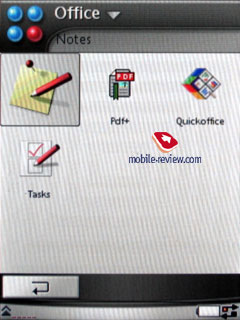
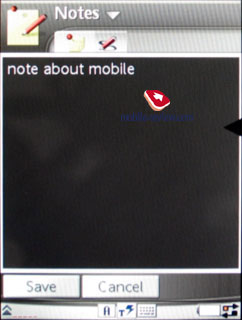

The second application is called PDF +. As you
can guess, it is used for viewing files in PDF format. Viewing is
possible both in landscape and in vertical modes. The application
became available for various versions of OS, including platform
60, some years ago. The Company Nokia has chosen this application
as preinstalled for a number of its devices (only trial version).
The full-function application is included in the standard delivery
kit of Sony Ericsson P990i. PDF + operates quickly, copes well both
with files in English and with documents submitted in different
encodings (though speaking about pdf the word "encoding"
sounds rather silly). Stand-alone application PDF + costs about
25 dollars.
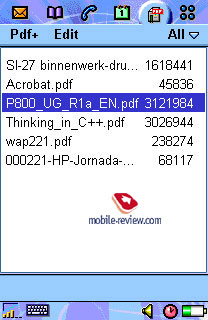
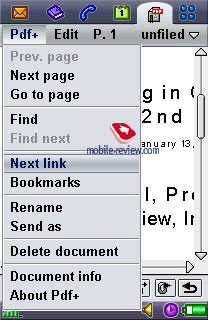


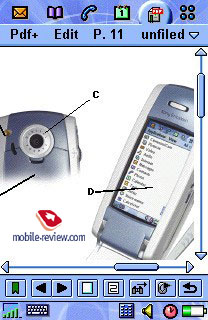
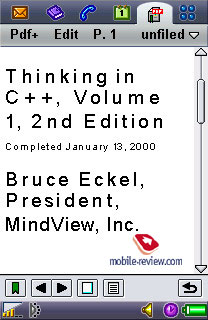
QuickOffice is another application by the third
company which was chosen by UIQ as a standard for the third version
and is included in the standard delivery kit (the version for previous
UIQ versions, platform 60, is available and costs about 50 dollars).
The application represents the editor which is able to open and
edit MS Word, Excel, PowerPoint files. Nowadays it is the best program
of such kind, what is proved by the UIQ and Nokia’s choice for its
smartphone (while only trial-versions in the latter case, but with
Sony Ericsson P990i appearance they will become full-fledged).
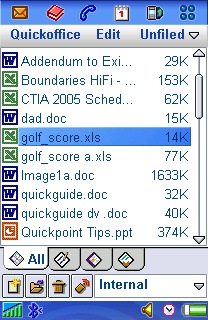
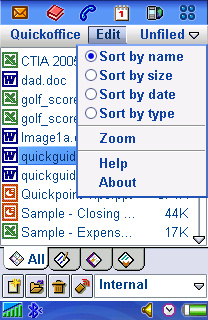
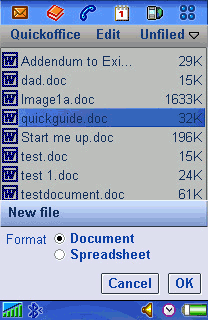
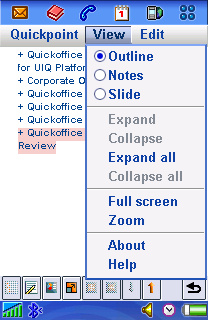
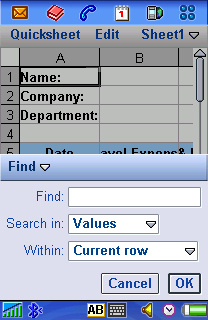
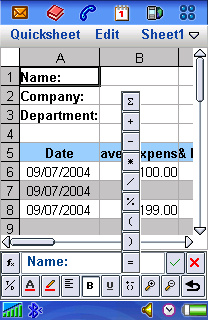

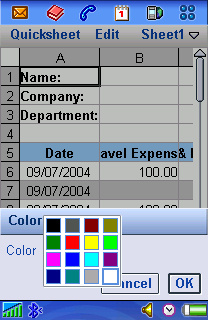
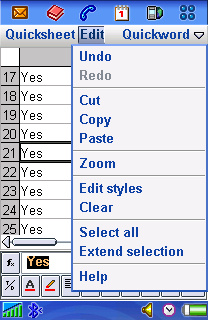
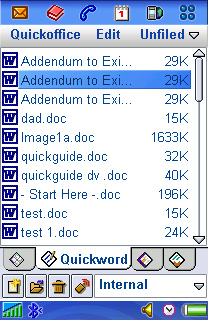
We will not describe the QuickOffice in detail. We will only note
that it is necessary to remember the limitation of any compact device’s
resources. Complex variants of formatting used in PC, are often
not kept in files edited in smartphones (it is not a problem of
only QuickOffice, but also of all devices on Windows Mobile).
Tasks. Writing tasks, priority setting, time limits
are available. In general everything is standard; there are no any
specific features.
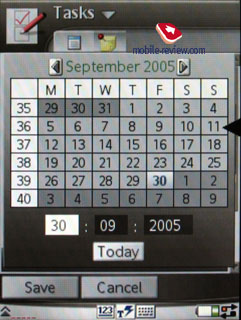
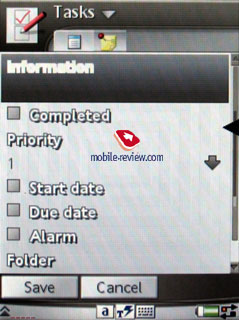
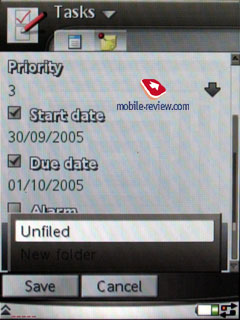
Some other functions, players, themes, web-browser
Calculator is usual and predictable, without any
tricks, but it differs from the standard for UIQ 3.0.
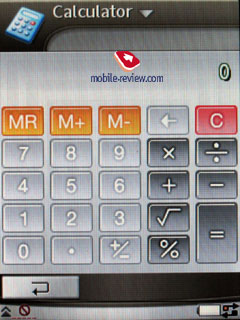
Voice - Dictaphone which allows making voice notes
(only in a stand by mode). It is possible to choose a format of
saved records. The interface is convenient and pleasant.

Graphics viewer - Small pictures are displayed
in the application; there is a transition to fast viewing of a picture
on the full screen. There are no any visible changes except of a
new button of sending MMS-message with a picture preview.
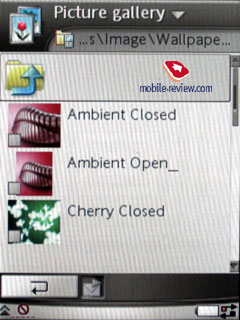

Image editor - The simple editor, allowing making
base operations with images.

MusicDJ - standard application by Sony Ericsson
has reached smartphones. It allows mixing several sound tracks.

Converter - Allows transforming various measure
units.
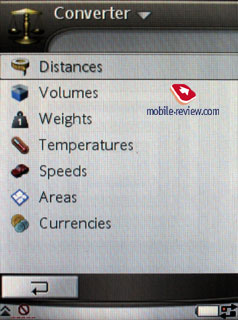
Stop watch - is present intermediate results gauging
and list maintenance are present.
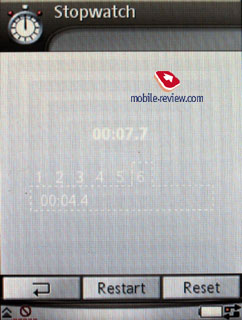
Countdown - time is set in hours and minutes and
the phone rings in a specified time.

Multimedia player - the device supports Real Audio
Video, MPEG4, 3GP formats. Audio formats such as AAC, mp3, AMR,
RMF, DLS, Real Audio, G-MIDI level 1 with 40 polyphonic tones MIDI,
WAV (up to 16 KHz sample-rate), XMF are remarkable. Playlists creation
and work in a background mode are supported.
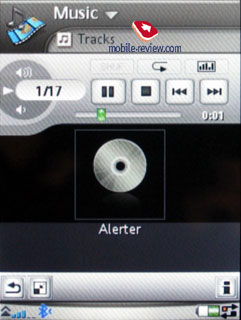
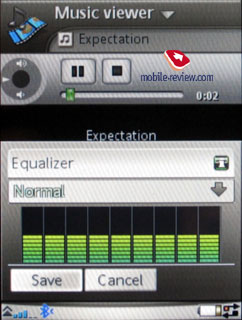
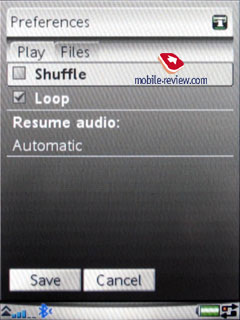
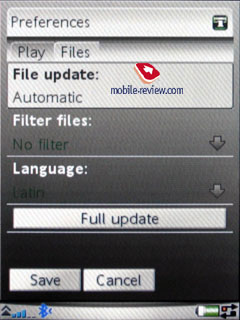
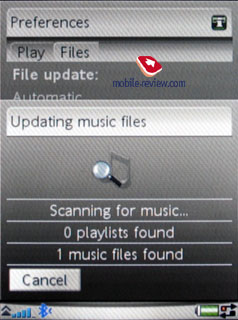
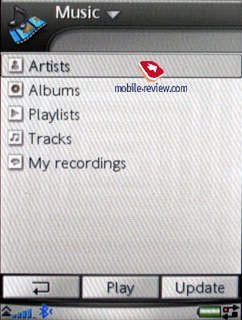
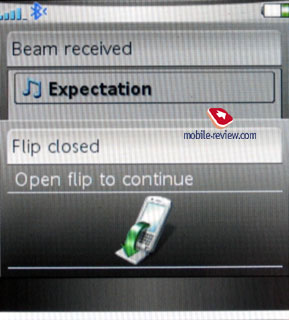
Themes are one of the central parts of new UIQ,
they visually change not only windows appearance and colors, but
separate menus and icons as well that allows to build essentially
other kinds of the interface. With the help of themes you may adjust
not only appearance, but sounds when pressing the screen, various
events and so forth. Here you may see the interface in three different
themes.



As a standard web-browser it is used Opera version 8. It is the
best browser for such devices, there is no alternative. It works
both in landscape and vertical modes of the screen, supports cookies,
scale pages according to the screen size. It is not desirable to
describe briefly all browser’s features, we shall devote a separate
article to it.


Programs, limits, other features
The UIQ 3.0 feature which was expected by many people is an opportunity
of programs working in a landscape-mode. Only Opera 8.0 and camera’s
interface has this opportunity of all preinstalled applications.
Creation of such programs will not be a problem for third developers
in future.
Having told about programs by third developers, it is necessary
to note they practically do not exist (during the review composing).
The early announcement of the device (5 months before the release
and in reality 6-7 months before) means that the manufacturer wants
to urge on development of such applications and expend maximum efforts
for this. There is no compatibility with with previous programs
versions developed for UIQ 2, because the new safety concept is
applied in UIQ 3.0. Programs for UIQ 2.1 must be recompiled with
partial change of a code. It results in spending much more time
by developers. We observed the similar situation with Ð800 when
the most part of applications appeared only in one year after the
beginning of the smartphone sales. I think this case will be approximately
the same. The most serious disadvantage of such situation is not
the absence of office applications (the standard set is quite sufficient)
but the lack of games (though games developers try to present them
as soon as possible for all devices). Lack of games at the first
stage will result in their increased cost for Ð990 (developers expectation
is simple - the device is expensive and less-common, games are also
rare, so it is possible to pay more for the game).
Digital Right management (DRM) - The full support of DRM is built-in
in UIQ 3.0. It means that the loaded videos, pictures and melodies
with the established rights cannot be transferred to other devices.
Having played with test music files with marked rights, I can confirm
that the DRM system for UIQ 3.0 works well.
Pleasant news is that there are no any restrictions on SIS/JAR
file size; the only limit is the device’s memory size or free memory
at the card.
Memory, memory manager, files manager
MS Duo Pro slot supports hot swap, the maximum card size is 4 Gb.
RAM counts 64 Mb while flash memory of the device is 128 Mb (80
Mb of them are available for the user and the rest is occupied by
preinstalled applications and the content).
Storage Wizard - is a standard application of
UIQ 3.0 which shows memory distribution in the device. Opening the
first bookmark one can view memory storage by separate types (the
device, memory card). In our case memory card number one is the
phone memory in reality (for some reason it is displayed so now).
The second bookmark represents the distribution of the memory used
by different applications.
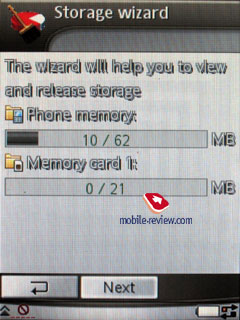

Files manager allows looking through the user’s
folders structure both in memory of the device, and on flash card.
You may choose several files or folders, remove them, copy or move.
Manager’s options are standard. Using it is possible to send some
files to other device using Bluetooth or IrDA.
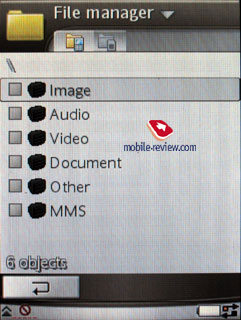
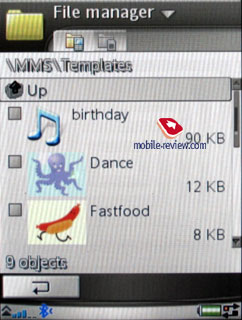
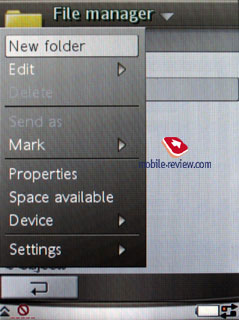
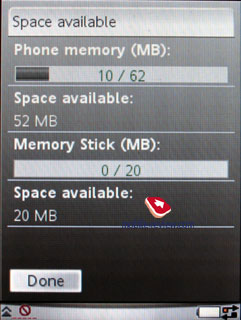
Impressions
Connection quality of Sony Ericsson P990i does not cause any censures,
the device works quite well in various conditions. Ring volume is
high, the smartphone is well heard. Taking into account the possibility
of setting mp3 as a ring tone it is not necessary to speak about
40-voice polyphony (hardly someone will use its options). The vibrating
alert is of the average force or hardly above. This point also does
not contain any differences from the previous model.


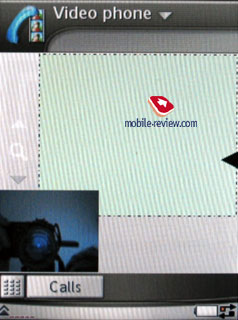


The leader of a product line by Sony Ericsson looks ambiguously
for traditional users of P-series. We may remember cut down functions
of JogDial, not always necessary QWERTY-keypad (and one language
for it by default), disputable configuration of managing elements.
But those innovations that appeared in the device make it to be
a real leader. Let’s list them:
- WiFi presence;
- 2-megapixel camera with maximum photo and video quality;
- UIQ 3.0 with very wide set of standard options;
- Support of all possible ways of text input;
- UMTS presence, video call support.
At the moment of Sony Ericsson P990i appearance similar products
by other manufacturers will not be sold in retail networks (there
will be something similar, but without touch screens). The device
will cost about 800-850 dollars in the beginning of sales and this
price is quite reasonable. The company starts focusing not only
to users crazy about technologies (techi), but mostly to mass business
audience. That is why the continuity of generations in the field
of ergonomics is not kept in comparison with P900/P910. The desire
to lard the device with the maximum number of functions and keep
cost at the same level developed into the interesting device. Possible
disadvantages for businessmen within the next year will include
only absence of Voice over IP support; this technology is present
and develops in products by Nokia (let’s remember Eseries).
It looks improbable that the device will be released in the first
quarter. Most likely, this will happen in April or even in May.
Delays are explained with the instability of UIQ 3.0 work. Final
validation of Sony Ericsson P990i inside the company of Sony Ericsson
is appointed to mid-January. Now the smartphone is not workable
(usual mistakes in UIQ 3.0, the same concerns to the interface of
the camera and other things). The majority of devices can be named
as partially alive.
I shall make a personal note. As the consecutive user of smartphones
by Sony Ericsson, I missed appearance of Ð910 as far as Ð900 absolutely
met my requirements at that moment. Ê750 appearance has forced to
refuse from Ð900 because with Opera Mini sites viewing became possible
on the small phone. Working with mail is organized in the same way
on both models and does not show any special opportunities. Other
functions are not so claimed outside of the office or home (do you
often look PDF-files or something similar in motion or when driving
car?). So, other applications of Ð900 could be attributed as almost
unusable. Nevertheless Sony Ericsson P990i, has a lot of chances
to be one of my devices for the following reasons:
- Almost normal postal client, support of MS Office investments
- WiFi Presence - for me it means an opportunity to load all
mail (30-40 mb), note necessary letters and remove unnecessary
during the lunch
- VPN - necessary function for corporate networks entrance, for
example, in Sony Ericsson, Nokia, Samsung.
- the normal camera; here there is a parity with Ê750i/W800i
- Viewing images on the large screen (Ê750 it is not absolutely
convenient in this point, Ð900 has the low-resolution screen too)
- Transferring sound by Bluetooth (I shall put my smart in a bag,
I don’t need it in hands)
It is my brief list of pluses. Minuses include degenerated ergonomics
to which it will be necessary to get used to.
Ultimately I’d like to note, that top solutions by Nokia gradually
aspire to get all features of devices on UIQ 3.0, in particular,
of Sony Ericsson P990i. It chooses the same additional programs,
develop the interface of a 60th series in the same direction (it
becomes closer and closer with every Future Pack), and supports
many solutions similar to UIQ 3.0. In a result, I suppose, we shall
see rather interesting struggle of two devices of the next generation.
At present Sony Ericsson P990i has no such big safety factor, as
its predecessors. It will be a leader in the market of Symbian-smartphones
up to the end of 2006, until Nokia will make rather good offer.
Top Sony Ericsson P990i updating will appear only in the middle
of 2007. In 2006 we shall see two more Symbian-devices by Sony Ericsson,
but they will have lower class.
P.S. For sure we shall expand this review consisting of three parts
with the description of the new camera interface, examples of photos
and video. Also the greater number of Sony Ericsson P990 screens
photos in various modes of operation will be added in existing parts
of the review. But the basic strong and weak features of the smartphone
are already specified here, they will not change at all. You can
form your opinion about the device on the basis of our review.
Review Sony Ericsson
P990. Part 1>>>
Review Sony
Ericsson P990. Part 2>>>
Eldar Murtazin (eldar@mobile-review.com)
Translated by Yana Vilchek (yana_vilchek@yahoo.com)
Published — 28 October 2005
Have something to add?! Write us... eldar@mobile-review.com
|
News:
[ 31-07 16:21 ]Sir Jony Ive: Apple Isn't In It For The Money
[ 31-07 13:34 ]Video: Nokia Designer Interviews
[ 31-07 13:10 ]RIM To Layoff 3,000 More Employees
[ 30-07 20:59 ]Video: iPhone 5 Housing Shown Off
[ 30-07 19:12 ]Android Fortunes Decline In U.S.
[ 25-07 16:18 ]Why Apple Is Suing Samsung?
[ 25-07 15:53 ]A Few Choice Quotes About Apple ... By Samsung
[ 23-07 20:25 ]Russian iOS Hacker Calls It A Day
[ 23-07 17:40 ]Video: It's Still Not Out, But Galaxy Note 10.1 Gets An Ad
[ 19-07 19:10 ]Another Loss For Nokia: $1 Billion Down In Q2
[ 19-07 17:22 ]British Judge Orders Apple To Run Ads Saying Samsung Did Not Copy Them
[ 19-07 16:57 ]iPhone 5 To Feature Nano-SIM Cards
[ 18-07 14:20 ]What The iPad Could Have Looked Like ...
[ 18-07 13:25 ]App Store Hack Is Still Going Strong Despite Apple's Best Efforts
[ 13-07 12:34 ]Infographic: The (Hypothetical) Sale Of RIM
[ 13-07 11:10 ]Video: iPhone Hacker Makes In-App Purchases Free
[ 12-07 19:50 ]iPhone 5 Images Leak Again
[ 12-07 17:51 ]Android Takes 50%+ Of U.S. And Europe
[ 11-07 16:02 ]Apple Involved In 60% Of Patent Suits
[ 11-07 13:14 ]Video: Kindle Fire Gets A Jelly Bean
Subscribe
|




























































